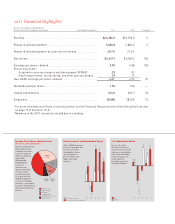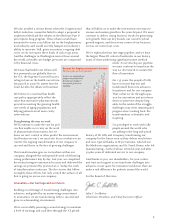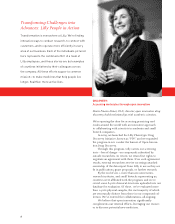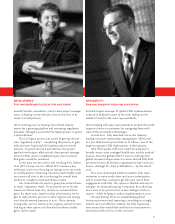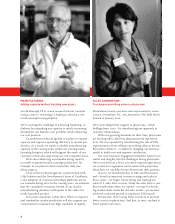Eli Lilly 2011 Annual Report Download - page 10
Download and view the complete annual report
Please find page 10 of the 2011 Eli Lilly annual report below. You can navigate through the pages in the report by either clicking on the pages listed below, or by using the keyword search tool below to find specific information within the annual report.
8
SALES & MARKETING:
Focusing on providing value to physicians
Michaelene Greenly, executive sales representative, neuro-
science, Greensboro, N.C., was featured in The Wall Street
Journal in January 2012.
We’re providing better support to physicians—while
holding down costs—by transforming our approach to
customer relationships.
With ever-growing demands on their time, physicians
are limiting sales calls from pharmaceutical representa-
tives. We’ve responded by transforming the role of Lilly
representatives from selling to providing value as doctors
themselves defi ne it—completely changing our business
model to build trust and improve satisfaction.
Our new Customer Engagement Model is based on re-
search and insights into the challenges facing physicians.
We’ve moved from a focus on reinforcing messages about
our products to a genuine conversation with physicians
about how we can help doctors better treat their patients.
In 2007, we launched pilots in Ohio and Wisconsin,
and—based on improved customer ratings and sales in
those states—we began restructuring and training our
entire U.S. sales force in 2009. Today the sales force is one-
third smaller than when we started—a recipe for shrink-
ing market share under the old sales model—yet we have
achieved continued growth in important Lilly brands.
Bottom line: We’re using fewer resources to provide
better service to physicians. And that, in turn, can lead to
better patient outcomes.
MANUFACTURING:
Adding capacity without building new plants
Jim McDonough, Ph.D., senior research advisor, manufac-
turing science & technology, is helping to develop a new
insulin manufacturing platform.
We’re meeting the challenge of achieving leadership in
diabetes by expanding our capacity to satisfy increasing
demand for our diabetes-care portfolio, while enhancing
our cost position.
An ambitious technical agenda is in place to expand
capacity and improve operating effi ciency in insulin pro-
duction. As a result, we expect to double manufacturing
capacity in the coming years within our existing manu-
facturing footprint, which will support the needs of our
customers while also improving our cost-competitiveness.
We’re also enhancing our manufacturing capacity
to enable expanded insulin cartridge production, for
example, at our plant in Sesto Fiorentino, Italy (see
photo, page 3).
A key to this technical agenda, in partnership with
Lilly Diabetes and the Development Center of Excellence,
is the adoption of common technology platforms across
our manufacturing sites. In the coming years, we estimate
that the cumulative economic benefi t of our insulin
manufacturing initiatives will equate to the value of a
newly launched product.
Even more important is that these efforts to improve
and standardize insulin production will also support our
commitment to maintain our high standards of quality.
This photo: © Travis Dove for
The Wall Street Journal



